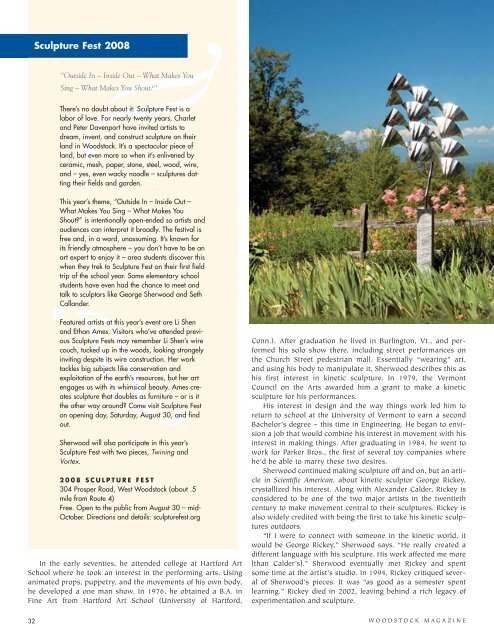George Sherwood Kinetic Sculpture
George Sherwood Kinetic Sculpture
George Sherwood Kinetic Sculpture
You also want an ePaper? Increase the reach of your titles
YUMPU automatically turns print PDFs into web optimized ePapers that Google loves.
In the early seventies, he attended college at Hartford Art<br />
School where he took an interest in the performing arts. Using<br />
animated props, puppetry, and the movements of his own body,<br />
he developed a one man show. In 1976, he obtained a B.A. in<br />
Fine Art from Hartford Art School (University of Hartford,<br />
32<br />
<strong>Sculpture</strong> Fest 2008<br />
“Outside In – Inside Out – What Makes You<br />
Sing – What Makes You Shout?”<br />
�<br />
�<br />
There’s no doubt about it: <strong>Sculpture</strong> Fest is a<br />
labor of love. For nearly twenty years, Charlet<br />
and Peter Davenport have invited artists to<br />
dream, invent, and construct sculpture on their<br />
land in Woodstock. It’s a spectacular piece of<br />
land, but even more so when it’s enlivened by<br />
ceramic, mesh, paper, stone, steel, wood, wire,<br />
and – yes, even wacky noodle – sculptures dotting<br />
their fields and garden.<br />
This year’s theme, “Outside In – Inside Out –<br />
What Makes You Sing – What Makes You<br />
Shout?” is intentionally open-ended so artists and<br />
audiences can interpret it broadly. The festival is<br />
free and, in a word, unassuming. It’s known for<br />
its friendly atmosphere – you don’t have to be an<br />
art expert to enjoy it – area students discover this<br />
when they trek to <strong>Sculpture</strong> Fest on their first field<br />
trip of the school year. Some elementary school<br />
students have even had the chance to meet and<br />
talk to sculptors like <strong>George</strong> <strong>Sherwood</strong> and Seth<br />
Callander.<br />
Featured artists at this year’s event are Li Shen<br />
and Ethan Ames. Visitors who’ve attended previous<br />
<strong>Sculpture</strong> Fests may remember Li Shen’s wire<br />
couch, tucked up in the woods, looking strangely<br />
inviting despite its wire construction. Her work<br />
tackles big subjects like conservation and<br />
exploitation of the earth’s resources, but her art<br />
engages us with its whimsical beauty. Ames creates<br />
sculpture that doubles as furniture – or is it<br />
the other way around? Come visit <strong>Sculpture</strong> Fest<br />
on opening day, Saturday, August 30, and find<br />
out.<br />
<strong>Sherwood</strong> will also participate in this year’s<br />
<strong>Sculpture</strong> Fest with two pieces, Twining and<br />
Vortex.<br />
2008 SCULPTURE FEST<br />
304 Prosper Road, West Woodstock (about .5<br />
mile from Route 4)<br />
Free. Open to the public from August 30 – mid-<br />
October. Directions and details: sculpturefest.org<br />
Conn.). After graduation he lived in Burlington, Vt., and performed<br />
his solo show there, including street performances on<br />
the Church Street pedestrian mall. Essentially “wearing” art,<br />
and using his body to manipulate it, <strong>Sherwood</strong> describes this as<br />
his first interest in kinetic sculpture. In 1979, the Vermont<br />
Council on the Arts awarded him a grant to make a kinetic<br />
sculpture for his performances.<br />
His interest in design and the way things work led him to<br />
return to school at the University of Vermont to earn a second<br />
Bachelor’s degree – this time in Engineering. He began to envision<br />
a job that would combine his interest in movement with his<br />
interest in making things. After graduating in 1984, he went to<br />
work for Parker Bros., the first of several toy companies where<br />
he’d be able to marry these two desires.<br />
<strong>Sherwood</strong> continued making sculpture off and on, but an article<br />
in Scientific American, about kinetic sculptor <strong>George</strong> Rickey,<br />
crystallized his interest. Along with Alexander Calder, Rickey is<br />
considered to be one of the two major artists in the twentieth<br />
century to make movement central to their sculptures. Rickey is<br />
also widely credited with being the first to take his kinetic sculptures<br />
outdoors.<br />
“If I were to connect with someone in the kinetic world, it<br />
would be <strong>George</strong> Rickey,” <strong>Sherwood</strong> says. “He really created a<br />
different language with his sculpture. His work affected me more<br />
[than Calder’s].” <strong>Sherwood</strong> eventually met Rickey and spent<br />
some time at the artist’s studio. In 1994, Rickey critiqued several<br />
of <strong>Sherwood</strong>’s pieces. It was “as good as a semester spent<br />
learning.” Rickey died in 2002, leaving behind a rich legacy of<br />
experimentation and sculpture.<br />
WOODSTOCK MAGAZINE


